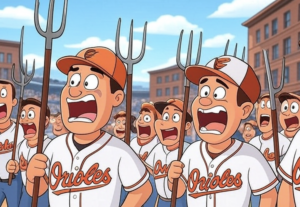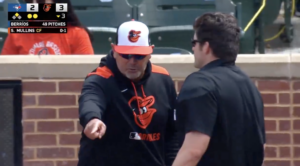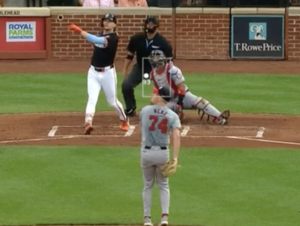They say you can’t ruin the great ones. But the Orioles seem like the only team that could ruin a current Cy Young Award winner and two fourth-overall draft picks. In case you haven’t filled in the blanks, I’m speaking about Jake Arrieta, Dylan Bundy and Kevin Gausman, respectively.
Jake Arrieta
We’ll start with Arrieta here in part one of this series. I’ll talk about the others in future installments.
Jake was drafted in the 5th round out of Weatherford College in Texas in the 2007 draft by the Baltimore Orioles. In Baseball America, he was ranked the 52nd best prospect in baseball prior to the 2009 season. He flew through the minors, posting the following numbers before making his major league debut in 2010:
– 2007 (Arizona Fall League): 0.00 ERA, 0.938 WHIP, 9.0 SO/9, 3.9 BB/9, 16 IP
– 2008 (Frederick, A+): 2.87 ERA, 1.159 WHIP, 9.6 SO/9, 4.1 BB/9, 113 IP
– 2009 (Bowie, AA): 2.59 ERA, 1.153 WHIP, 10.7 SO/9, 3.5 BB/9, 59 IP
– 2009 (Norfolk, AAA): 3.93 ERA, 1.418 WHIP, 7.7 SO/9, 3.2 BB/9, 91 2/3 IP
– 2010 (Norfolk, AAA): 1.85 ERA, 1.123 WHIP, 7.9 SO/9, 4.2 BB/9, 73 IP
Each step (A+ AA, AAA) saw Jake decrease his ERA, while his WHIP remained stable. So when he came up in 2010*, great things were expected. Alas, it was a disappointing rookie campaign. In a tad over 100 IP, Arrieta posted a 4.66 ERA, 4.7 SO/9, 4.3 BB/9 and a 1.535 WHIP. He just couldn’t strike anybody out, nor could he command his pitches.
*As an aside, it’s important to note that Buck Showalter joined the Orioles in the middle of the 2010 season, managing his first game on August 3rd.
2011 wasn’t much better for Jake in regards to his control, but his strikeout rate spiked…along with his home run rate. His ERA went up to 5.05. His FIP spiked as well (5.34). Finally, in 2012, the Orioles had had enough. After posting a 6.13 ERA through July 5th, Arrieta was sent back to AAA. He didn’t dominate there, either.
After that, we know the story. After five games and a 7.23 ERA, Arrieta was sent, along with Pedro Strop, to the Chicago Cubs for Scott Feldman and Steve Clevenger. The Cubs sent him to AAA Iowa to work on his mechanics under the tutelage of a new organization and set of pitching coaches. In only 30 innings, Arrieta put up a strikeout rate of 11.6/9, his highest rate of any season, along with an ERA of 3.66. He was then called up to the majors. His progression since has been nothing short of astounding.
– 2013 (Cubs): 3.66 ERA, 1.123 WHIP, 6.4 SO/9, 4.2 BB/9, 51 2/3 IP
– 2014 (Cubs): 2.53 ERA, 0.989 WHIP, 9.6 SO/9, 2.4 BB/9, 156 2/3 IP
– 2015 (Cubs): 1.77 ERA, 0.865 WHIP, 9.3 SO/9, 1.9 BB/9, 229 IP
– 2016 (Cubs): 1.56 ERA, 0.893 WHIP, 9.0 SO/9, 3.0 BB/9, 75 IP
So what changed? This was an absolutely dramatic course of events. Just comparing the major league careers for each team (Orioles vs. Cubs):
– Orioles (4 years): 5.45 ERA, 1.472 WHIP, 7.0 SO/9, 4.0 BB/9, 358 IP
– Cubs (4 years): 2.16 ERA, 0.933 WHIP, 9.0 SO/9, 2.4 BB/9, 512 IP
I decided to look into Jake’s PitchFx data to see if anything changed. And boy, did something change.
Repertoire
With the Orioles, Jake was a four-seam fastball guy first. It was his main pitch. From 2010-2012, Jake’s pitches had the following breakdown:
2010
– Fastball: 543 – 32%
– Sinker: 518 – 30%
– Curveball: 250 – 15%
– Slider: 225 – 13%
– Change-up: 169 – 10%
– Total pitches: 1,705
2011
– Fastball: 911 – 44%
– Sinker: 355 – 17%
– Slider: 333 – 16%
– Curveball: 323 – 15%
– Change-up: 165 – 8%
– Total pitches: 2,087
2012
– Fastball: 661 – 34%
– Sinker: 520 – 27%
– Curveball: 311 – 16%
– Slider: 291 – 15%
– Change-up: 146 – 8%
– Total pitches: 1,929
It’s pretty evident that Jake was a fastball, sinker and curveball guy, but he was a four-seam fastball guy first. Since going to Chicago, as we can see when looking at the same data from 2013 through 2016, he changed his repertoire completely. It’s important to note that the Cubs really wanted Jake to work on throwing his cutter more. His slider designation is really a slider/cutter type. (For more on that, see this article).
Jake’s pitch breakdown changed dramatically from 2013 (keep in mind that this data includes Orioles and Cubs) to today.
2013
– Sinker: 475 – 38%
– Fastball: 357 – 29%
– Curveball: 190 – 15%
– Slider: 174 – 14%
– Change-up: 45 – 4%
– Total pitches: 1,241
2014
– Slider (Cutter): 699 – 29%
– Sinker: 599 – 25%
– Fastball: 519 – 22%
– Curveball: 429 – 18%
– Change-up: 133 – 6%
– Total pitches: 2,379
2015
– Sinker: 1,225 – 36%
– Slider: 989 – 29%
– Fastball: 537 – 16%
– Curveball: 531 – 15%
– Change-up: 145 – 4%
– Total pitches: 3,427
2016
– Sinker: 450 – 40%
– Slider: 239 – 21%
– Fastball: 234 – 21%
– Curveball: 141 – 13%
– Change-up: 48 – 4%
– Total pitches: 1,112
Let’s focus primarily on 2014-2016, since these years were the years Jake was exclusively with the Cubs. Jake is now a slider/sinker guy first. Over the last two-plus seasons, he’s thrown those pitches 60% of the time. His fastball is now being thrown around 20%. Contrast this with the O’s where Arrieta threw his fastball 37% of the time from 2010-2012.
I’ll touch on the cutter dilemma more in depth later when speaking about Bundy, but I just want to leave this quote from Dan Duquette in 2012 right here (via Steve Melewski, through FanGraphs):
“Why don’t you take a look at the chart with the average against cutters in the big leagues, batting average against and then come back and tell me that that’s a great pitch,” Duquette said. In an interview with Steve Melewski that is destined to provide content for weeks, Dan Duquette outlined the Orioles’ philosophy when it comes to the cut fastball. In essence, the pitch won’t be taught in their minor league organization. “We don’t like it as a pitch,” the Baltimore GM said.
Needless to say, the change in repertoire has paid dividends for Arrieta and the Cubs. Bringing back the slider/cutter to the forefront has transformed Arrieta.
Time to the Plate
On top of that, one of the other issues that Jake dealt with when pitching for the Orioles under Buck Showalter for Jake was his TTTP (time to the plate). As we all know, Buck makes a very big deal about keeping runners close and controlling the running game, and he wants his pitchers getting the ball to the plate quickly with men on. In the past, I’ve written about how pristine Jake’s numbers were when there were no runners on base, compared to his numbers when runners were on base. The difference was night and day:
Runners on:
– 2010: .256/.343/.372 – .715 OPS
– 2011: .245/.347/.469 – .815 OPS
– 2012: .296/.366/.484 – .850 OPS
– 2013: .236/.354/.377 – .731 OPS*
– 2014: .227/.283/.310 – .593 OPS
– 2015: .194/.274/.298 – .572 OPS
– 2016: .141/.213/.172 – .385 OPS
Bases empty:
– 2010: .284/.366/.445 – .811 OPS
– 2011: .259/.339/.433 – .772 OPS
– 2012: .255/.300/.399 – .699 OPS
– 2013: .204/.307/.401 – .708 OPS*
– 2014: .189/.246/.256 – .502 OPS
– 2015: .181/.217/.259 – .476 OPS
– 2016: .173/.256/.259 – .515 OPS
*Keep in mind 2013 part of it was w/ the Orioles and the other with the Cubs.
Each year with the O’s, we saw a drop in Jake’s batting average, OBP and slugging against with the bases empty, but with runners on base we saw it steadily climb…until dropping in 2013 once he was in Chicago (he started five games for the Orioles that year).
When you’re not throwing your best pitches due to an organizational edict and you’re constantly worried about your mechanics/TTTP due to a Buck mandate, you’re not going to be at your best. In short order, Jake went over to the Cubs and quickly made changes that dropped his WHIP dramatically (in the same year as the trade). He, quite simply, didn’t have to worry as much when runners reached base. On top of that, every year thereafter his numbers with runners on base were fantastic.
It’s not entirely difficult to pinpoint the various reasons for Jake Arrieta’s failures with the Orioles organization. As I pointed out above, there were just a few big reasons: TTTP and worrying about mechanics when runners are on, and an organizational insistence to essentially ban the cutter. But there’s one last thing I wanted to touch on before wrapping this postmortem of Arrieta’s career in Baltimore.
The Pitching Coach Merry-Go-Round
Jake Arrieta’s time in Baltimore from 2010-2013 saw a slew of pitching coach changes that can only be described as flabbergasting:
– Rick Kranitz: 2008-2010
– Mark Connor: 2011
– Rick Adair: 2011-2013
– Bill Castro: 2013
– Dave Wallace: 2014 – present
Arrieta (as well as Zach Britton, Brian Matusz and others) all had at least three pitching coaches, and perhaps as many as five. This turnover of pitching coaches under Showalter was certainly troubling, but it also did no favors to Jake. Perhaps the most detrimental of the bunch was Adair. Last month, Jeff Passan of Yahoo! got some quotes from Britton that made O’s fans raise our eyebrows a bit, while also, unfortunately, nodding knowingly.
“They took away the individual approach to everything. “Things we did extremely well in the minor leagues to get to the big leagues – we were told that just doesn’t work here. And you’re like, ‘That’s kind of weird, right?’ You don’t just reinvent yourself in the big leagues. That was the struggle. And the struggle, as we got older, was trying to get back to what made us what we were before.”
As ESR’s own Ryan Blake opined:
The coaching staff seemed to make more of an effort to improve upon the pitchers’ weaknesses rather than focusing on building up their strengths. In Arrieta’s case, Adair and his staff took away Jake’s cutter, which is now his most dominant pitch.
Britton said it best. You don’t just reinvent yourself in the big leagues. The entire point of the minors is to develop. Once you make it to the majors, you should be as polished as possible. But that wasn’t the case with most of the Orioles highly touted prospects.
And it certainly wasn’t the case with Jake Arrieta.
I know, I know…we’re all tired of hearing about Arrieta at this point. But those who don’t remember the past are doomed to repeat it. So, will the O’s repeat their painful past with their next crop of young pitchers?
In part two, we’ll look at how things have been going thus far with Dylan Bundy…











One Response
I still think that the Orioles should have released Tillman as he was horrible this year. There are so many pitchers the Orioles messed up right?